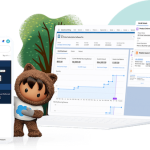While Singapore’s M1 may have started out as a traditional telco, the experience it provides rivals that of the industry’s digital natives. Innovation is in M1’s DNA and its digital transformation has uplifted service and resulted in an incredible Net Promoter Score (NPS) of 60.
Salesforce is a partner in M1’s ongoing transformation to become a digital-first telco, and we recently met with Stamford Low, Director, Customer Experience & Retail, to learn more about how his team is progressing and the lessons learned along the way. Here are key takeaways showing that exceptional customer experiences start with engaged employees.
Drive adoption with friction-free experiences
M1 operates in a digitally-savvy society, but old habits can be hard to change. For customers to self-serve or purchase a new phone and contract online, the process must be as convenient as dropping into a local store. That’s why M1 continues to streamline its digital journeys and remove any points of friction.
“If we provide frictionless digital journeys, customers won’t have a need to use legacy assisted channels,” said Stamford.
The same logic applies to new tools and processes for employees. M1’s employees have embraced robotic process automation (RPA) and new applications because they can see the value they provide. These technologies eliminate repetitive and mundane tasks, making it easier to serve customers.
“Our employees love the agent and sales consoles in Salesforce because of the user experience. Thanks to our agile way of building things, they’ve also been able to provide input into how we cluster and display information on screens,” said Stamford.
Customer experience and productivity are inextricably linked
Call deflection is a common measure of success for service-focused organisations. However, for M1, it is secondary. Its primary goal is to provide a better digital experience.
“The starting point for us is not call deflection or call avoidance because that’s inward-looking. We want to focus on making the customer journey so proactive that there’s no need for the customer to call,” said Stamford. “If we know that there is something wrong with your mobile service, for example, why should we wait for you to call us? We should be reaching out first, either through our app or an outbound call.”
When customers do reach out, M1 wants to ensure an efficient response — whether it is from an agent or the telco’s chatbot Mindy. Einstein Next Best Action and continued enhancements to the agent and sales consoles will help increase the speed of customer service and improve the telco’s already high NPS.
“Our NPS is at a level that makes it difficult to keep improving and we have already harvested all the low-hanging fruit. That’s why we are challenging ourselves and using Einstein Next Best Action to be more proactive,” said Stamford.
The telco also plans to reorganise the information in its agent and sales consoles so that it is more aligned with the customer journey. For example, if a customer calls about a billing dispute, M1 wants to provide agents with everything they need to manage that dispute on a single screen.
“Data shows that first contact resolution (FCR) is the number one driver for transactional NPS. So the best way to improve FCR is to equip employees with the best tools to resolve customer queries,” said Stamford. “I believe that also translates into empowered employees and thus a better employee NPS.”
Transformation is a journey, not a sprint
We asked Stamford for tips on how to manage internal change and shift employee mindsets. He said that digital transformation is a journey. It is important for leaders to be aligned and to provide clear direction on where the journey is headed.
“Digitalisation is sometimes viewed as a threat to certain departments and certain roles. For example, there were concerns within our business that we would go 100% digital and close all our stores. However, management alleviated these concerns by making it clear that’s not our focus right now.”
“Some people still struggle with digital, so to cater to Singapore’s whole population we will still need stores. The question is how do we upskill our store staff and provide them with the knowledge in their tablets to sell in a personalised way,” said Stamford.
Upskilling is an essential element of M1’s transformation and the business has made this as easy and efficient as possible for employees. When processes change, for example, employees only need to learn what’s new rather than sit through training on what they already know. They can also find information on new processes and features in a library of articles built on Salesforce Knowledge.
Training time is 50% faster for new sales and service employees. Stamford attributes that partly to how easy the service agent and sales consoles are to use.
Commenting on the broader efficiencies offered by new digital capabilities, Stamford indicated that the need for efficiency and productivity was a given. What’s most important to him, though, is the impact on the customer.
“People always look for efficiency and productivity gains in operations because it leads to cost optimisation. However, I think about efficiency more from the perspective of how it can help us to provide a better customer experience,” said Stamford.
























